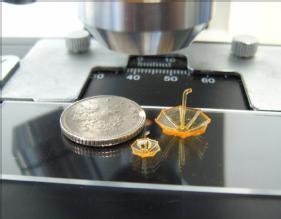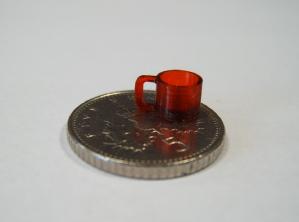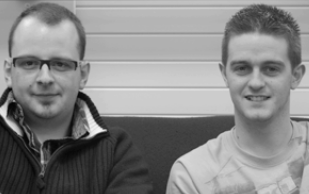Dr Simon Leigh & Chris Purssell
 |
 |
Saving for a rainy day |
Quick cup of coffee |
What got you interested in this area of science?
Dr Simon Leigh
My degree and PhD are in chemistry but I currently work in the Engineering department at the University of Warwick. I’ve always had an interest in engineering, so when the opportunity arose to use my chemistry knowledge and apply it with some engineering, it was the dream job. The research that we carry out looks at taking some polymer chemistry and combining it with some clever engineering in order to fabricate micro-scale components for MEMS (Micro-electro-Mechanical Systems), microsensors, microfluidics and biomedical engineering. As you can see from the pictures below, the level of detail we can achieve on the components we make is truly remarkable. It’s an exciting field to work in and each day we are finding new and innovative applications for the technology we use.
Chris Purssell
Having had an interest in anything technical related from a young age, a degree in engineering was always going to be the route for me. What first comes to mind for most people when someone talks about engineering are buildings, computers, and cars; things with nuts and bolts. While it is obvious how these are useful in everyday life, things on the sub-millimetre scale can be just as important. It is not every day you get to use machines that can convert and image on a computer screen to a real 3D part you can hold in your hand in only a few hours, particularly when the objects built are typically measured in millionths of a meter. So when I was given the opportunity to research and develop these systems I couldn't resist! We have made many advances to our facilities such that we now have the capability to build anything from fun parts like the tiny coffee cups or miniature umbrellas below, to much more complex (and useful) parts for use across the fields of science and engineering.
How is the work relevant to everyday life?
Direct Manufacturing, or DM for short, is used to produce three-dimensional (3D) components using an additive, layer-by-layer process. Specifically, we use a technique known as Micro-stereolithography (MSL), which offers the ability to produce exceptionally detailed components that would be impossible to fabricate in any other way. In order to make these components, a 3D digital model is drawn using computer design software and then digitally sliced into layers. The images of these layers are then fed one by one to a projector. The light from the projector is used to trigger a chemical reaction in the polymer, causing it to turn from a liquid into a solid. In this way, the final solid object can be built up a layer at a time in a matter of hours. The components we make find uses in all sorts of applications. Essentially, if you can think of something you want to make and a material you would like to make it out of, chances are we can build it for you. Technology like this is already being used for automotive industry prototyping or to make hearing aids, dental implants, detailed models for testing and gas sensors chambers for medical diagnostics. In the future, when combined with increasingly advanced materials, this technology for example will be able to manufacture a new custom-made bone implant directly from the scan taken in hospital or manufacture micro-sensors, designed to fit neatly into the location where they are to operate. More information about the technology we use and what we do can be found on our website at go.warwick.ac.uk/msl
What does your research hope to achieve?
Our research aims are twofold; firstly, we are aiming to continue developing DM technology so that objects with much finer detail and increased complexity can be manufactured from a range of advanced or smart materials. Secondly, our research is working towards developing low cost and highly accurate sensors and micro-devices as well as decreasing the time and cost of medical diagnostics and treatment.
Briefly, what does the image show?
A Quick Cup of Coffee
This image shows one of our MSL test pieces, a miniature coffee cup on top of a 5p piece. It started life as some liquid polymer before solidified a layer at a time to make the final object. To design and make a cup this small and detailed with other techniques would normally take a few days but this one was designed and made in just a couple of hours.
Saving for a Rainy Day
This image shows two more MSL test pieces, two umbrellas next to a 5p piece. These too, began life as some liquid polymer. The level of detail achieved on these pieces, especially with the handles of the umbrellas is excellent. The small umbrella for instance is made from approximately 300 layers, with each layer being 15 microns thick. The polymer used to make these umbrellas is currently undergoing tests as a material for use in manufacturing implants for hospital patients with bone and tissue damage.

